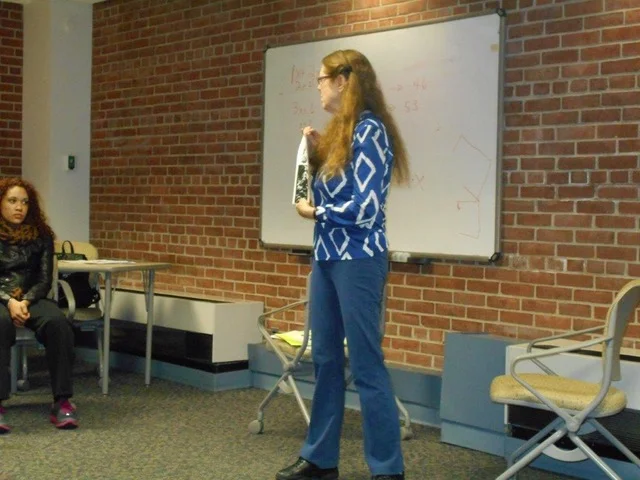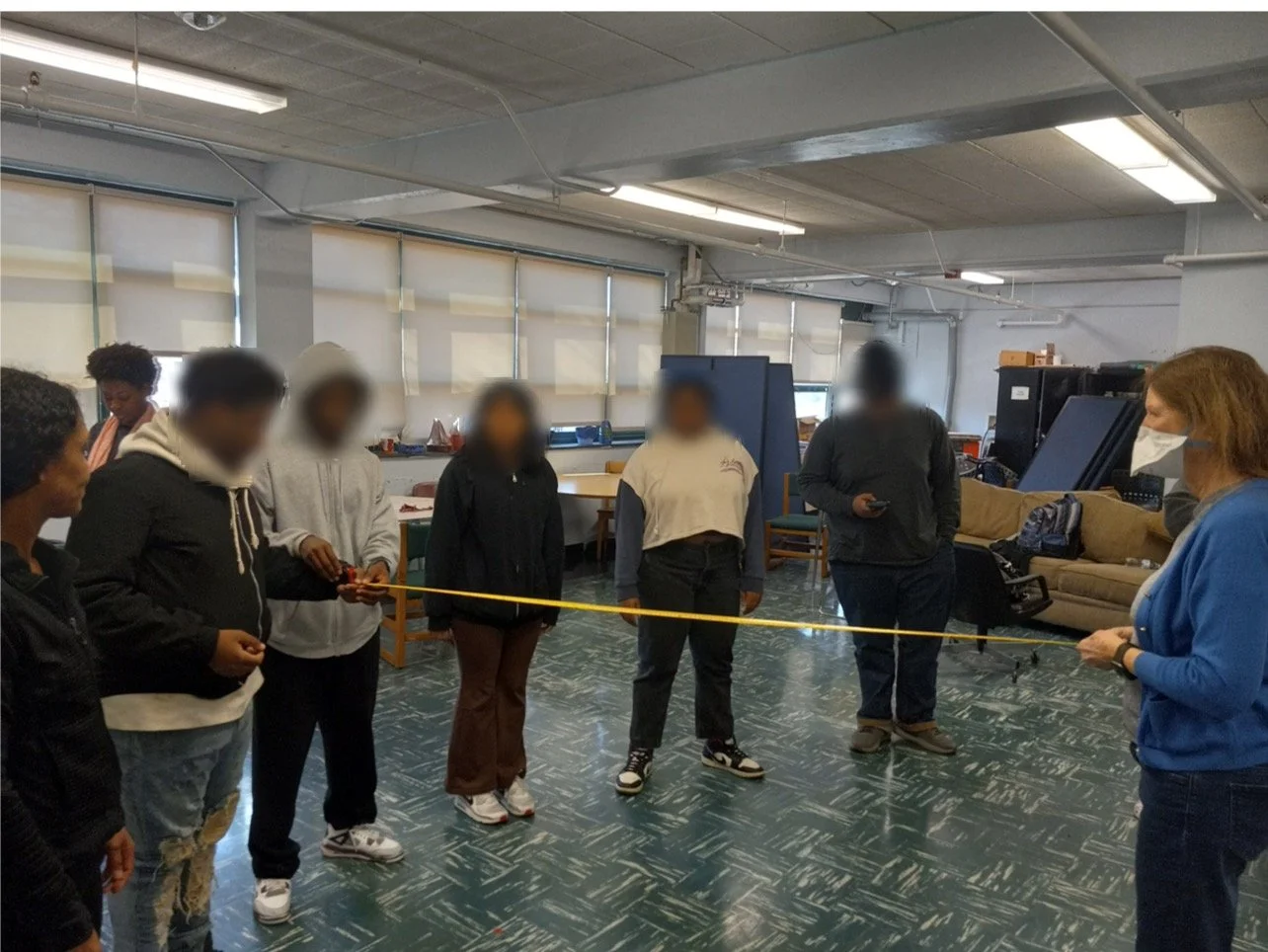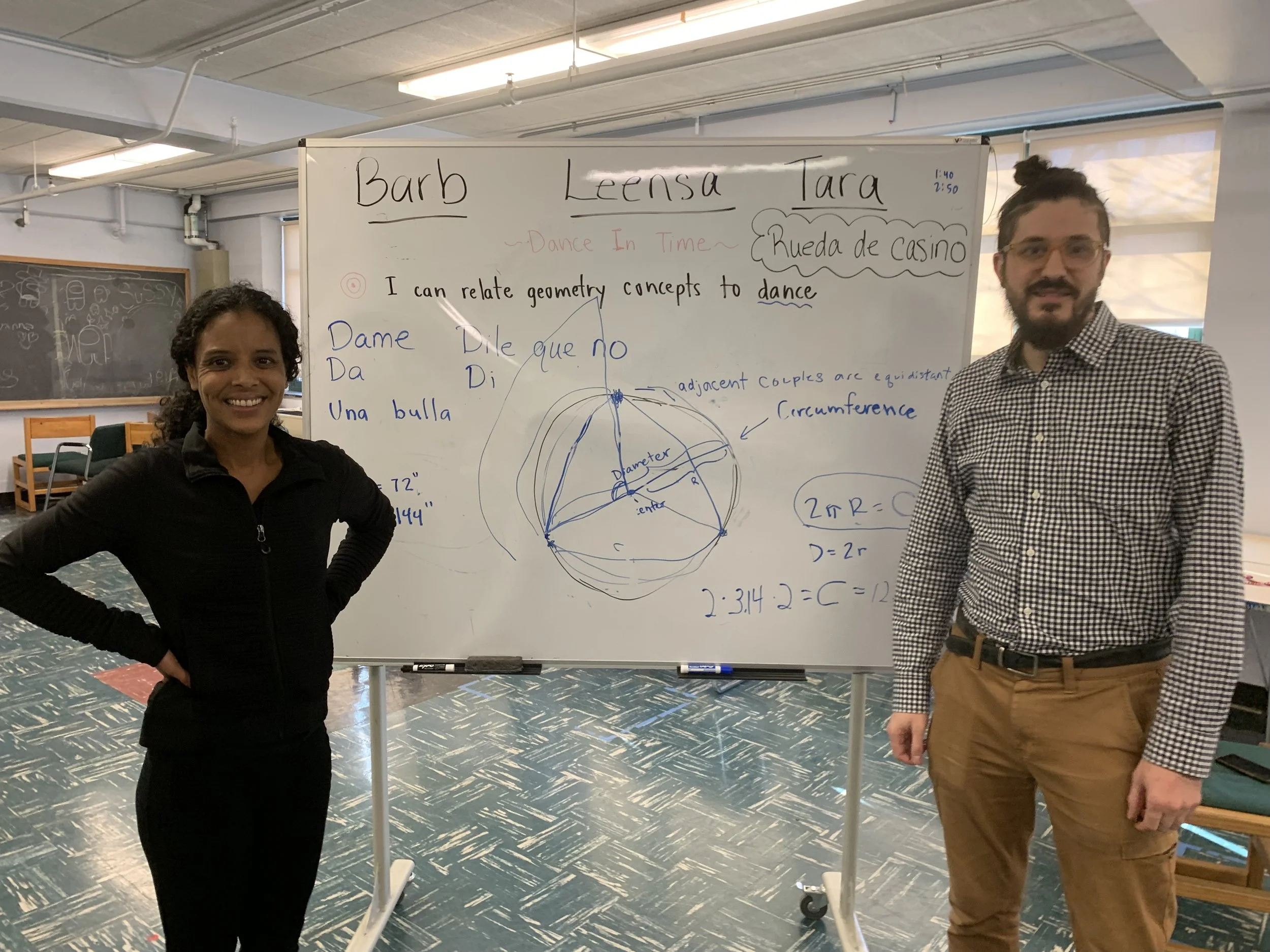ARTS INTEGRATION: INSPIRING STUDENTS TO LEARN
Below are some "Arts Integration" programs that blend the study of Latin Dancing with standard concepts in Mathematics, Science, and Social Studies curricula. For more information on Mathematics lessons, also see www.MathTeacherHelp.com.
PROGRAM # 1. (Grades 6-12)
Using Salsa Dancing To Teach Concepts In Middle and Upper School Mathematics and Physics
A variety of principles in STEM subjects (Math/Science) can be illustrated by aspects of dancing Rueda de Casino. This dance is done by couples in a circle, with frequent partner exchanges. For this lesson, just a few simple dance moves such as Guapea, Dame, Fly, Dos Fly, Besitos, Bulla, and Foto could be taught. (The English meaning of Spanish words that are used in calls—such as “Dame” and “Bulla”—can also be pointed out as a side-line to the math lesson.)
The two options below are for different levels of attention and mathematical sophistication, depending on what is most suitable for the students in a particular class. Also, high school geometry students may not yet have covered some of the topics that the program in option 1 is based on. In that case, explaining/teaching the underlying mathematics may be difficult in the short time left after learning the dance. With the goal of “meeting students where they are,” option 2 presents an arts integration program focused on less advanced geometric principles. This may be more suitable for some classrooms. The option 2 material was developed primarily by Leensa Fufa and Tara Spruill-Jones who helped me (Barb Bernstein) orchestrate this program at a Baltimore public high school.
Option 1:
As dancers arrange themselves around a circle, I often remind them to watch their placement on the floor so they are evenly spaced out. This simple direction alone can generate some “circle geometry” math problems. For example, if a point is made at the midpoint between a leader and follower who are partners, that point can be used to construct a line that is a tangent to the circle. This means that line touches the circle in exactly one (and only one) point. The point where it touches the circle is called the “point of tangency.” If the points of tangency between adjacent couples are connected in a “circle” of 3 couples, the lines thus created would form an equilateral triangle when couples are evenly spaced around the circle. In a circle of 4 couples those lines would form a square.
The fact is that regardless of how many couples there are in the circle, the lines created by connecting these points of tangency would create a regular polygon. This is actually a rigorous way to define what it means for the dance couples to be “evenly spaced” around the circle. And the arc between each pair of adjacent couples would be the same number of degrees as well. In fact, that would be another, equivalent way to rigorously define what it means for couples to be evenly spaced around the circle.
If this is diagrammed on a classroom blackboard, many other mathematical relationships can be observed. All radii in a circle are of equal length. So a set of congruent triangles are created when radii to all points of tangency are drawn, as well as the lines between all adjacent points of tangency. Since the central angles of these triangles are equal to the arcs they “cut off” on the circle, the central angles must also be equal when the arcs are equal. Furthermore, the number of degrees in the central angles will always be 360 divided by the number of couples. So in a circle with 3 couples, those angles are 120 degrees. In a circle with 6 couples, the angles are 360 divided by 6 which is 60 (degrees), etc.
The triangles within the circle that are created by these lines can be proven to be congruent by a “side-angle-side” proof. That is, both radii are equal to the radii in the other triangles and the angles between those radii are the same in all the triangles. When two sides as well as the angle between them are equal to two sides and the angle between them in another triangle, the triangles are congruent. (This means if you put one triangle on top of another, they would completely coincide.)
Changing the number of couples who are dancing or the size of the radius (or both!), essentially gives you “the same problem with different numbers." So students can run through the exercise again and practice all the computations with new numbers.
In addition, imagine extending all of the tangent lines described above. If lines are extended in both directions, it would create another, larger “regular polygon,” meaning that all sides of the polygon are the same length. So in essence, there are a number of mathematically rigorous ways of “proving” or defining what it means for couples to be evenly spaced around the circle.
To further expand the lesson, the same number of dancers can dance in a larger circle, concentric to the original one. (Concentric circles have the same center.) Students can compare dancing in different-sized circles, given that the leaders must move around the circumference to get to a new partner during the Dame step. The formula for the distance around the circle, which is called the “circumference” is this: Circumference equals two times 𝝅 times the radius (“c=2𝝅r”). So if the radius doubles or is multipled by amu constant, the circumference also doubles or is multiplied by the same constant. This generates problems involving ratio and proportion. For example, if the large circle has a radius that’s double the size of the small circle, what is the radius of the big circle when the radius of the small circle is 8 feet? Or if the circumference of the large circle is 1.6 times the circumference of the small circle, what is the circumference of the small circle if the circumference of the large one is 12 feet?
Physics principles of speed and momentum can be discussed by considering a dancer moving along the circle’s arc between the points of tangency made by adjacent couples. If leaders move to the same music (or any music with the identical tempo) in a circle with double the radius, the path leaders traverse is double the length. This is true even though the number of degrees in the arc they are traversing is the same. That means leaders have to move twice as fast. That makes stopping at the destination point more difficult because the dancer has more momentum. The formula for this is “momentum equals mass times velocity (speed).” Thus, dancers must be prepared to move faster to cover a greater distance but stay on the beat, and also exert themselves to stop quickly despite their momentum when they get to their new partner.
Imagine four couples in a circle, for example. If a new circle is created with the same dancers but a radius three times as long as in the original circle, then the leaders will have a path three times as long to cover when they move to a new partner. They are still moving around a fourth of the circle’s arc, but the pathway they cover is far longer in the bigger circle. They have the same amount of time (number of beats) to move around as they did in the smaller circle. So they must move faster which makes it harder to stop, according to the laws of momentum.
Students are measuring the distance between each class member and the center of the circle. For the Latin dance the students learned, it’s important for everyone to be situated on the circumference. That means everyone should be the same distance from the center.
Option 2:
After students learn some Rueda de Casino steps, they see firsthand the importance of staying on the circumference of the circle. Proving that all the dancers are on the circumference creates a discussion about the definition of a circle (points all equidistant from the center) and the meaning of a radius and a diameter. In a program run at a Baltimore public school, students learned to dance Rueda de Casino and then discussed how to be “mathematically sure” that they were all on the circle circumference. They had the option of measuring distance with a piece of yarn, a rope, or a measuring tape. Someone stood in the middle and everyone stood along the circle and we measured the distance from the center to each student. We also looked at the equation for the circumference of a circle (C=𝝅D or C=2𝝅R), noting that the diameter can be expressed either as “D” or as 2 times the radius (“R”).
The concept of the constant, pi is also relevant to these equations. So the class could talk about ways pi is represented, such as 3.14 or 22/7. It is also an example of an irrational number which means that its digits do not repeat. (Students may find it interesting that some people make a hobby of memorizing the decimal value of pi to a large number of decimals!)
We pointed out how many degrees dancers are turning in the dance, as they move to a new partner. Since followers face the circumference and then the center, they turn just under 90 degrees while leaders turn just under 180 degrees as they move facing forward to the next partner along the circle.
The arc of the circle between each couple can be computed if a radius is assigned. With a radius of 3 meters and, say, 4 couples, leaders have to move the full circumference divided by 4 to get to a new partner. The equation mentioned above for the circumference can be used to compute the full circle circumference and then that can be divided by the number of couples dancing. Students to solve the problem of finding the distance each leader travels for a partner exchange, and changing the number of dance couples (or the radius) creates a new problem with different numbers!
Danceintime teacher Leensa is posing with the Geometry teacher by a whiteboard showing Mathematical formulas and calculations that were applied to a form of Latin dancing.
Students can be shown the meaning of some math terms on a diagram of the dance circle. These include: equidistant, equilateral, degrees of an angle, pi, pentagon, hexagon, septagon, octagon, “tangent,” and “point of tangency.” The terms above ending in “gon” can be illustrated by drawing a circle with couples along the circumference and connecting the points where each couple is standing to the adjacent points. For example, a square is created by drawing a line from each couple to the adjacent couples when there are four couples; a pentagon is created when there are five couples, etc.
Polygons are also created by extending lines that are tangents to the circle indefinitely. A tangent touches the circle at only one point. If the location of each couple is the point where the tangent touches the circle (called the point of tangency) then extending those tangents creates lines creates a one dimensional polygon, or plane figure. This may also lead to a discussion about what it means to be a shape in two dimensions (as opposed to three dimensions).
The area of a circle can be reviewed as well. To make a direct application to the dance, this question could be asked: Suppose you had an outdoor stage that would be put down on top of grass using dance flooring that is several one-foot square blocks. How many squares on the floor would you need to have every point on the circumference be at least one foot inside the edge of the dance floor?
Dance teachers use math in countless ways! The key to successful instruction, including arts integration or any other program, is to present lessons the students are ready for. So teachers can start with the art lesson and move to academic principles in whatever depth the students are interested in and ready to grasp.
PROGRAM #2. (Grades 4 to 7)
Mathematical Calculations In Preparing a Salsa Performance
Option #1:
In preparing a dance performance, calculations must be made to ensure that the music has the right number of beats for the choreography. In addition, the sound of the music must end after a musical phrase. (This makes the presentation "feel finished.") These calculations can be made by the students so they see how math plays into performance preparation.
A Salsa phrase is often four or eight sets of "8 beats." This computation offers a perfect opportunity to use base 4 or base 8, instead of our base 10 system. One would want the final number of beats in a piece of music to be divisible by 4, which could be represented with a zero in the "one's place" if the counting were done in base 4. Likewise, if the number of beats was divisible by 8, then in base 8, there would be a zero in the “one’s place.” This is a bit sophisticated, but even without the complicated idea of other base systems, this situation provides an opportunity to show how math is used in the arts. Just the simple calculations done in our ordinary base 10 to get music cut and prepared for a show, requires a fair amount of mathematics.
This lesson would involve students learning a few dance moves, counting the beats in each, and then figuring out how they would choreograph a presentation using those moves. It would include artistic considerations such as what order to do the moves, as well as technical ones.
A class could also watch some advanced moves that they didn’t learn themselves and have fun using their math knowledge to create an “advanced choreography” even if the students themselves couldn’t perform that choreography. Essentially, they’d be playing the role of a choreographer rather than a dancer. Students could be given a list of a dozen advanced moves and watch a video of them. Then they could decide which ones they would like to include in a 1.5-minute choreography. They would have to figure out how long each move would take so they don’t go over or under the time allowed.
For example, Kentucky Complicado is a move that takes 72 beats because it runs for 9 sets of 8-beat phrases. If the music is 200 beats/minute which is a typical Salsa tempo, then students can figure out how many seconds that move will take. This is a ratio and proportion problem where 200/60 (200 beats per 60 seconds) equals 72/x (72 beats in an unknown number of seconds). That would be solved by finding that 200x= 4320. Then x=432/20 which is approximately 22 seconds. So Kentucky Complicado and 3 additional moves of about that length could be fit into a 1.5-minute choreography.
Option #2:
A simpler version of this program can be run simply having students do some Salsa shine patterns and choosing an order to put them in for a short presentation. We ran a program teaching side rocks, back rocks, front rocks, right turns, grapevines, mambo steps, etc and had the students decide on the order of these components for a 30-second presentation. They calculated how many beats the music had for 30 seconds if the music was 200 beats per minute. Then the students created the choreography for a solo Salsa presentation using the patterns they had learned. The program can conclude with questions about what adjustments would need to be made if the music were faster—such as 220 beats per minute, or slower such as 180 beats per minute, etc.
PROGRAM # 3. (Grades 4 to 12: Social Studies)
Hispanic Culture and Its Contribution To the World
A lesson on Latin dancing makes a very natural addition to a social studies unit on Latin America. The dance lesson could cover three or four popular Latin dances (e.g. Bachata, Merengue, Salsa, Rueda de Casino, and Cha Cha). These dances originated mostly in Latin countries of the American hemisphere. Music and dance are very important in Latin culture and a study of these dance rhythms is a nice way to honor the culture.
This short Danceintime Documentary Film on Casino and Salsa dancing (youtu.be/ywFWErpb_do) would be interesting for students to watch. It even features a remarkably able group of Cuban children dancing in a circle. The film discusses how Latin music and dancing have been "exported" so that people all over the world now enjoy it.



